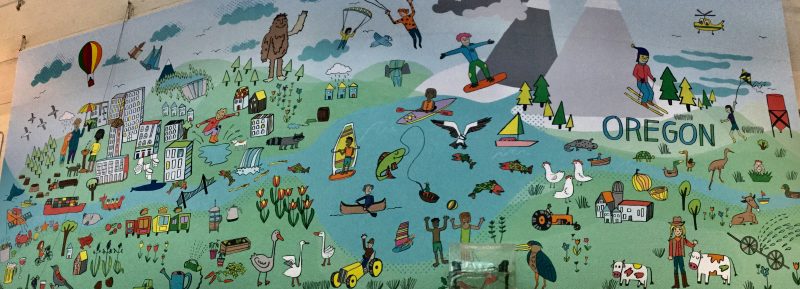
How can Oregon make progress in its fight against car abuse when cars represent one of the largest sectors of our state’s economy?
It feels good for Oregon bicycle advocates to talk about “bikenomics,” but the truth hurts: our state’s auto industry is a behemoth that casts a very long shadow. According to an article published Sunday in the Portland Tribune, there was $10.6 billion in new vehicle sales in 2016 (the latest year figures are available). That amounts to a whopping 17.9 percent of all retail sales statewide.
As the Trib story says, auto dealers are celebrating a “banner year” as they ready for their biggest moment — the annual Portland Auto Show held at the Oregon Convention Center this weekend.
Here’s more from the Trib piece:
“… the sales figures only hint on the impact that new car dealers have in the state. For starters, there were 218 of them in state in 2016, more than enough for at least one in every city of any size. Each employed an average of 60 people. The total payroll was $716
billionmillion, with $305 million paid in state and federal income taxes.“Just about the only equivalent employer is the state are school districts,” says Remensperger [executive vice president of the Metro Portland New Car Dealers Association]…
But the dealerships supported even more indirect and induced jobs in their community, bringing the total number they created in 2016 to 27,045 — a sizeable percent of the state’s total workforce by any measure.
“This economic engine provides jobs and incomes that in turn create vibrant livable communities around the state. We are proud that our industry helps bring families together, creates lasting memories and serves the communities where we live,” says Chris Meier, a partner at the Herzog-Meier Auto Center, president of the Metro Portland New Car Dealers Association and vice-president of the Oregon Auto Dealers Association.”
Advertisement

(Photo: J. Maus/BikePortland)
These should be sobering statistics for people who want to see Oregon prioritize transit and bicycling over single-occupancy auto use.
Here are some of the questions I’m thinking about after seeing that article:
➤ When most lawmakers and community leaders see cars as a vital piece to our economic puzzle, how can we create a political environment where car use is seen not as a benign behavior, but for what it also is: an extremely costly (to its users, government, and the public), environmentally harmful, public safety threat that should be done sparingly and only when other options are not available?
➤ Is it possible to achieve our transportation and environmental goals and maintain a healthy and robust auto industry?
➤ Could a comparable economic boost be provided by a state that dramatically improves its public transit and bicycling networks?
Whether overt or behind-the-scenes, there’s no denying the power of the auto industry in Oregon. As our department of transportation begins a conversation about congestion pricing, I hope we can separate what’s good for long-term policy from what’s good for short-term pocketbooks.
— Jonathan Maus: (503) 706-8804, @jonathan_maus on Twitter and jonathan@bikeportland.org
Never miss a story. Sign-up for the daily BP Headlines email.
BikePortland needs your support.


